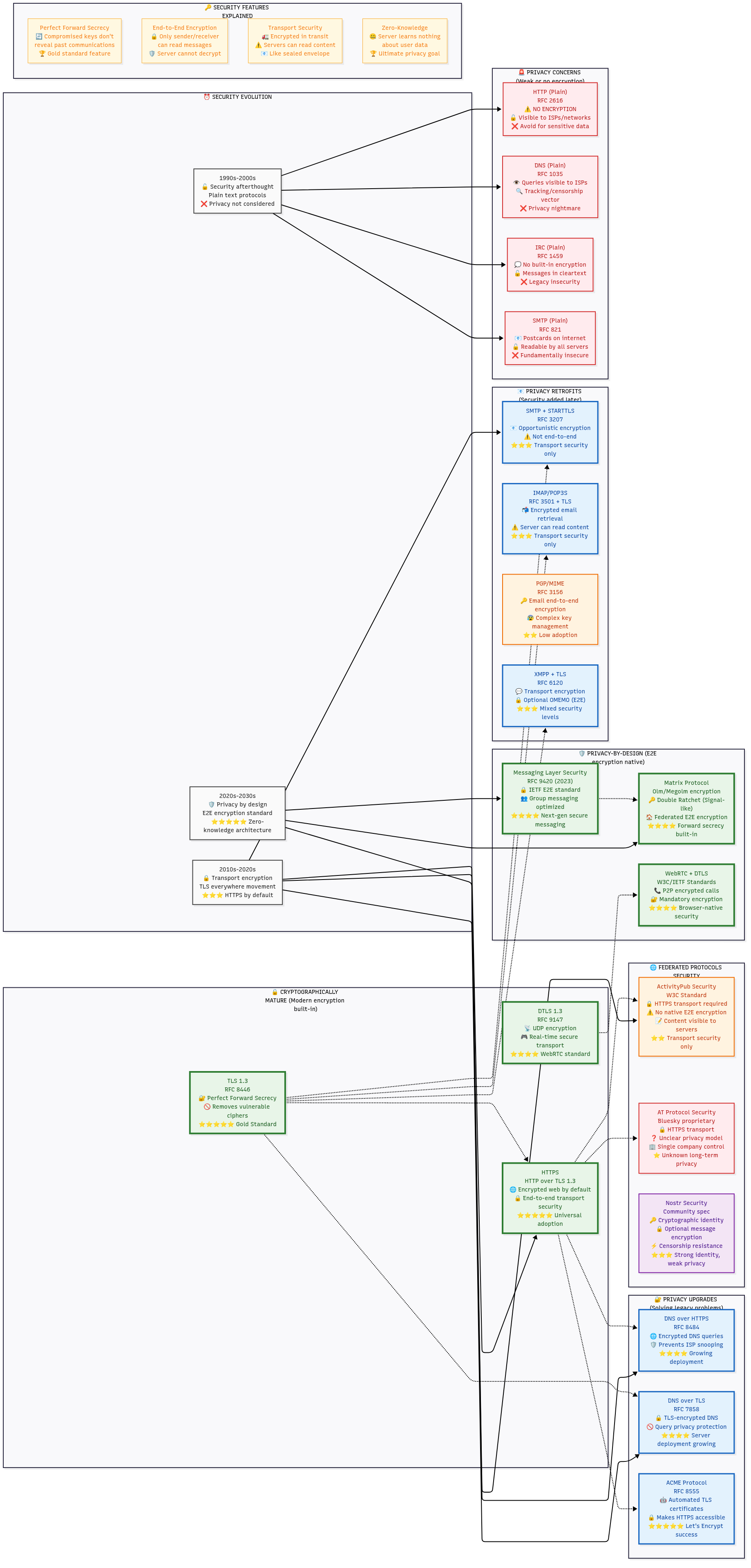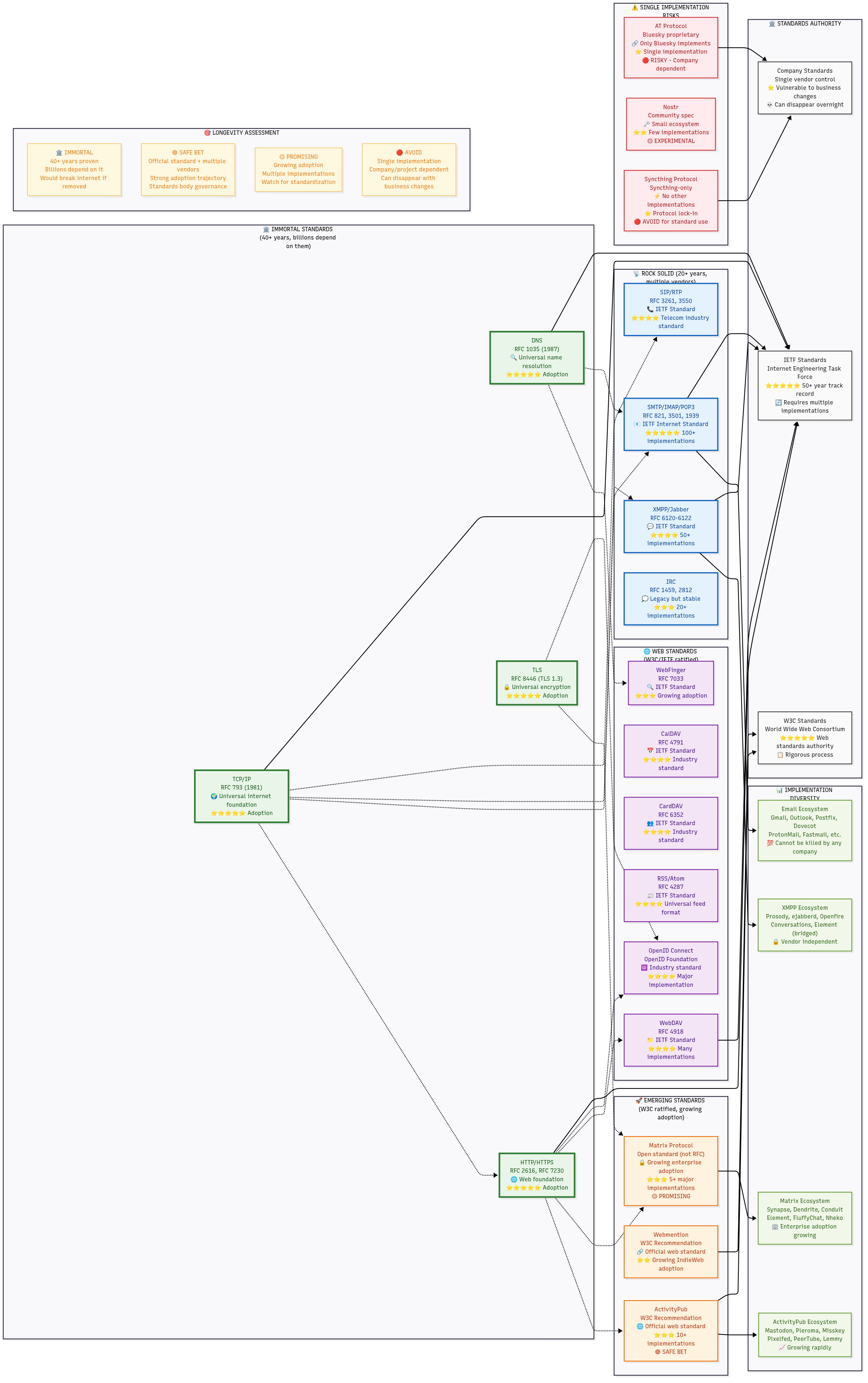Digital Sovereignty: Breaking Free from Vendor Lock-in Without Sacrificing Security or Usability

How to choose communication, social media, and file storage tools that keep you in control
In an era where Big Tech platforms dominate our digital lives, millions of users find themselves trapped in what academics call "surveillance capitalism" - a system where your personal data becomes the product, and switching services becomes practically impossible due to ecosystem lock-in. But there's a growing movement toward digital sovereignty: taking back control of your data, communications, and digital identity through strategic technology choices.
This isn't about becoming a hermit or sacrificing all convenience. It's about making informed decisions that balance privacy, security, and usability while ensuring you can always take your data and move elsewhere if needed.
The Hidden Cost of "Free" Services
When Google launched Gmail in 2004, it seemed revolutionary: 1GB of free storage when competitors offered mere megabytes. But the true cost became apparent over time. Today's tech giants use what business researchers call "platform lock-in" strategies - they make it increasingly difficult to leave by creating interconnected ecosystems where departing one service means losing functionality across multiple services.
Consider the typical Google user: Gmail handles their email, Google Calendar manages their schedule, Google Drive stores their files, Google Photos holds their memories, and Google Meet facilitates their video calls. Leaving means not just finding alternatives to five different services, but also migrating years of data, retraining muscle memory, and potentially losing the ability to collaborate seamlessly with contacts who remain in the Google ecosystem.
This creates what economists call "switching costs" - barriers that make changing services expensive in time, effort, or functionality. The higher these costs, the more trapped users become, even when they're dissatisfied with privacy policies, service quality, or pricing changes.

The Foundation: Understanding Open Standards vs. Proprietary Protocols
The key to digital freedom lies in understanding the difference between protocols and platforms. A protocol is like a language that different software applications can speak to communicate with each other. A platform is a specific implementation of that protocol by one company.
Email provides the perfect example. SMTP (Simple Mail Transfer Protocol) is the open standard that governs how email works. Because it's an open standard managed by the Internet Engineering Task Force (IETF), anyone can build email software that interoperates with everyone else's. This is why you can send an email from Gmail to someone using Outlook, ProtonMail, or a self-hosted email server - they all speak the same protocol language.
Contrast this with proprietary messaging platforms like WhatsApp, Telegram, or Discord. Each uses its own proprietary protocol, creating isolated islands. WhatsApp users can only message other WhatsApp users. This gives the platform owner tremendous power - they control who can participate, what features are available, and can change terms of service knowing users can't easily migrate their social connections elsewhere.
The strategic insight is clear: choose tools built on open standards with multiple implementations. This ensures that no single company can control your digital life or hold your data hostage.
The Security Spectrum: When to Encrypt and When Not To
Not all digital content requires the same level of security, and understanding this spectrum is crucial for making practical decisions that balance privacy with usability.
End-to-end encryption represents the gold standard of privacy - only the sender and intended recipients can read the content, even the service provider cannot decrypt it. This is essential for private communications, sensitive documents, and any content where exposure could cause harm. However, E2E encryption comes with a critical trade-off: if you lose your encryption keys, your data is gone forever. No customer support can recover it.
Transport encryption (like HTTPS) protects data while it travels between your device and the server, but the service provider can still read the content. This is perfectly adequate for many use cases - public social media posts, collaborative documents, or personal files where the convenience of account recovery outweighs the privacy benefit of E2E encryption.
Server-side encryption means your data is encrypted when stored on the provider's servers, but they hold the keys. This protects against data breaches but not against the service provider itself accessing your data.
The practical approach is a tiered security model: use E2E encryption for truly sensitive communications and data, transport encryption for most general use, and plaintext only for genuinely public content.
🏆 Optimal Choices
| Protocol/Service | Lock-in Prevention | Security/Privacy | Recoverability | Best Use Case | Notes |
|---|---|---|---|---|---|
| SMTP/IMAP + STARTTLS | ⭐⭐⭐⭐⭐<br/>100+ implementations<br/>Universal portability | ⭐⭐⭐<br/>Transport security<br/>Server can read content | ⭐⭐⭐⭐⭐<br/>Account recovery<br/>Multiple backup methods | Primary email | Gold standard for interoperability. Use with reputable providers like Fastmail/Proton |
| CalDAV/CardDAV | ⭐⭐⭐⭐⭐<br/>IETF standard<br/>Many implementations | ⭐⭐⭐<br/>Transport security<br/>Standard encryption | ⭐⭐⭐⭐⭐<br/>Easy export/import<br/>Standard formats | Calendar/Contacts sync | Perfect for escaping Google Calendar lock-in |
| WebDAV (Nextcloud) | ⭐⭐⭐⭐<br/>Open standard<br/>Multiple providers | ⭐⭐⭐⭐<br/>Server-side encryption<br/>Optional E2E | ⭐⭐⭐⭐⭐<br/>Full data export<br/>Admin recovery | Personal cloud storage | Excellent Google Drive alternative with options |
🔒 High Security Choices
| Protocol/Service | Lock-in Prevention | Security/Privacy | Recoverability | Best Use Case | Notes |
|---|---|---|---|---|---|
| Matrix Protocol | ⭐⭐⭐⭐<br/>Multiple homeservers<br/>Can self-host | ⭐⭐⭐⭐⭐<br/>E2E encryption<br/>Forward secrecy | ⭐⭐<br/>Key backup complex<br/>Lose keys = lose history | Private messaging & groups | Best federated E2E messaging. Backup keys carefully |
| XMPP + OMEMO | ⭐⭐⭐⭐⭐<br/>20+ implementations<br/>Fully decentralized | ⭐⭐⭐⭐<br/>Optional E2E encryption<br/>Strong when configured | ⭐⭐⭐<br/>Depends on server policy<br/>Key management issues | Technical users messaging | Great for tech-savvy users who configure properly |
| Email + PGP | ⭐⭐⭐⭐⭐<br/>Uses standard email<br/>Universal compatibility | ⭐⭐⭐⭐⭐<br/>Strong E2E encryption<br/>Full content privacy | ⭐<br/>Lose private key = all gone<br/>No recovery possible | Sensitive email communication | Ultimate email privacy but key management is critical |
⚖️ Balanced Choices
| Protocol/Service | Lock-in Prevention | Security/Privacy | Recoverability | Best Use Case | Notes |
|---|---|---|---|---|---|
| ActivityPub (Mastodon) | ⭐⭐⭐⭐<br/>W3C standard<br/>10+ implementations | ⭐⭐<br/>Transport security only<br/>Server sees content | ⭐⭐⭐⭐<br/>Data export available<br/>Can migrate instances | Public social media | Best Twitter alternative. Good for public discourse |
| RSS/Atom | ⭐⭐⭐⭐⭐<br/>Universal standard<br/>Countless readers | ⭐⭐⭐<br/>Transport security<br/>Public by design | ⭐⭐⭐⭐⭐<br/>Standard format<br/>Easy backup/migration | Content syndication | Perfect for following blogs, news without platform lock-in |
| ProtonMail | ⭐⭐⭐<br/>Uses IMAP bridge<br/>Some vendor lock-in | ⭐⭐⭐⭐⭐<br/>E2E encrypted email<br/>Zero-access encryption | ⭐⭐⭐<br/>Account recovery<br/>Password reset possible | Secure email for non-technical users | Good balance of security and usability |
⚠️ Risky Choices
| Protocol/Service | Lock-in Prevention | Security/Privacy | Recoverability | Best Use Case | Notes |
|---|---|---|---|---|---|
| AT Protocol (Bluesky) | ⭐<br/>Single implementation<br/>Company-controlled | ⭐⭐<br/>Transport security<br/>Unclear privacy model | ⭐⭐⭐<br/>Data portability promised<br/>Untested in practice | Early social media adoption | Wait for multiple implementations before trusting |
| Syncthing | ⭐<br/>Proprietary protocol<br/>Single implementation | ⭐⭐⭐⭐<br/>P2P encryption<br/>No central server | ⭐⭐<br/>Device-dependent<br/>No cloud recovery | Device-to-device sync only | Good tool but creates protocol dependency |
| Google Workspace | ❌<br/>Proprietary APIs<br/>Vendor lock-in | ⭐⭐<br/>TLS transport<br/>Google reads everything | ⭐⭐⭐⭐⭐<br/>Excellent recovery<br/>Never lose data | ❌ Avoid if possible | High lock-in, poor privacy. Migrate away gradually |
Building Your Digital Independence Strategy
Email: The Foundation of Digital Identity
Email remains the closest thing we have to a universal digital identity system. Almost every online service requires an email address for registration, password resets, and communications. This makes your email provider choice foundational to your entire digital strategy.
The path to email independence involves three key decisions:
Own your domain: Instead of using @gmail.com or @yahoo.com, register your own domain name and use it for email. This might seem technical, but many email providers now make it simple. The benefit is enormous - you can switch email providers while keeping the same email address, maintaining continuity with contacts and services.
Choose based on your threat model: If you're primarily concerned with avoiding vendor lock-in and maintaining good privacy from advertisers, services like Fastmail or Migadu offer excellent features with strong privacy policies and full IMAP support. If you need protection from more sophisticated threats or legal demands, ProtonMail provides end-to-end encryption with a user-friendly interface.
Plan for portability: Ensure your chosen provider supports standard protocols (IMAP/SMTP) and offers easy data export. Avoid proprietary features that would make migration difficult.
Messaging: Balancing Privacy and Network Effects
Messaging represents one of the most challenging areas for digital sovereignty because of network effects - the value of a communication platform depends largely on who else uses it. The most private messaging app in the world is useless if none of your contacts use it.
Matrix Protocol emerges as the most promising solution for those seeking both strong privacy and vendor independence. Unlike proprietary messaging platforms, Matrix is an open standard that supports end-to-end encryption while allowing federation between different service providers. You can run your own Matrix server, choose from multiple hosted providers, or even bridge to other messaging platforms.
The Element client provides a user-friendly way to access the Matrix network, offering features competitive with Slack or Discord while maintaining the ability to switch providers or self-host. The key advantage is that Matrix servers can interoperate - users on different Matrix servers can communicate seamlessly, preventing the fragmentation that plagues other decentralized messaging attempts.
For broader social messaging, XMPP remains a mature option with decades of stability and multiple client implementations, though it requires more technical knowledge to configure securely.
Social Media: Reclaiming Public Discourse
The rise of federated social media, often called the "Fediverse," offers the most viable path away from corporate-controlled social platforms. Built on the ActivityPub protocol (a W3C web standard), platforms like Mastodon, Pixelfed, and PeerTube create an interconnected network where users can interact across different services and providers.
The beauty of ActivityPub is interoperability - you can follow a photographer on Pixelfed from your Mastodon account, comment on PeerTube videos, and share content across the entire federated network. If you become dissatisfied with your chosen server's policies or administration, you can migrate to another server while maintaining your social connections.
This federation model solves the network effects problem that has historically made social media alternative unsuccessful. Instead of trying to convince all your contacts to join a new, isolated platform, ActivityPub creates a growing ecosystem where choosing any compatible service gives you access to the entire network.

File Storage and Collaboration: Beyond the Cloud Giants
Personal file storage and collaboration tools represent perhaps the easiest area to achieve digital independence, as the technical barriers are lower and the network effects less critical than with communication tools.
Nextcloud stands out as the most mature alternative to Google Workspace or Microsoft 365. Built on open web standards like WebDAV, CalDAV, and CardDAV, Nextcloud provides file synchronization, calendar and contact management, collaborative document editing, and dozens of other features through its app ecosystem.
The flexibility is remarkable - you can self-host Nextcloud on your own hardware, use one of many managed Nextcloud providers, or even migrate between providers while maintaining full functionality. Your calendar, contacts, and files use standard formats that work with a wide variety of client applications.
For simpler needs, WebDAV-compatible services offer excellent alternatives to Dropbox or Google Drive. Many providers offer WebDAV access, allowing you to use standard file sync clients and avoid proprietary sync applications that could become obsolete.
The strategic advantage of standards-based file storage extends beyond just avoiding vendor lock-in. When your calendar uses CalDAV and your contacts use CardDAV, you can use the best client applications for each platform - the native Calendar app on iOS, Thunderbird on desktop, DAVx⁵ on Android - while keeping your data synchronized across devices through your chosen provider.
The Migration Playbook: Making the Transition
Achieving digital sovereignty isn't an all-or-nothing proposition. The most successful approach involves gradual migration, starting with the foundations and building up:
Phase 1: Establish Identity Independence
- Register your own domain name
- Set up email forwarding from your domain to your current provider
- Begin using your domain-based email address for new accounts
Phase 2: Email Migration
- Choose and set up a new email provider that supports your domain
- Configure email clients to use IMAP/SMTP
- Gradually update important services to use your new email address
- Set up forwarding from old addresses during the transition period
Phase 3: Communication Platforms
- Install Matrix/Element and connect with contacts who are already there
- Use bridges to connect Matrix to other messaging platforms during transition
- Begin migrating group conversations and communities
Phase 4: Social Media Transition
- Create accounts on ActivityPub platforms (Mastodon, Pixelfed, etc.)
- Export data from existing social platforms
- Cross-post content during transition to maintain audience
- Gradually shift activity to federated platforms
Phase 5: File and Calendar Independence
- Set up Nextcloud or WebDAV-compatible file storage
- Migrate calendar and contacts to CalDAV/CardDAV providers
- Export documents and files from proprietary platforms
- Configure sync clients on all devices
Addressing Common Concerns
"But all my contacts are on WhatsApp/Instagram/Gmail!" This is the classic network effects problem, but federation protocols solve it differently than previous alternatives. Instead of trying to convince everyone to move to the same new platform, you're joining a growing ecosystem where different servers and applications can interoperate. Your contacts can be on different Mastodon servers, Matrix homeservers, or email providers while still maintaining seamless communication.
"This sounds too technical for most people." The technical barrier has dropped significantly in recent years. Services like Element (Matrix), Mastodon instances, and hosted Nextcloud providers offer user experiences comparable to mainstream platforms. The key is starting with user-friendly providers before considering self-hosting options.
"What about reliability and support?" Many open-source and federated services now offer enterprise-grade reliability and support. Email, the internet's most successful federated system, demonstrates that distributed architectures can be more reliable than centralized platforms - if one email server goes down, others continue functioning.
"How do I know these alternatives will stick around?" The beauty of open standards is that they outlive individual companies. Email protocols from the 1980s still work perfectly today because they're not controlled by any single entity. ActivityPub is a W3C web standard, Matrix has growing enterprise adoption, and protocols with multiple implementations create competitive markets that drive innovation rather than stagnation.
The Economics of Digital Sovereignty
One persistent myth is that achieving digital independence requires significant financial investment. In reality, many privacy-respecting, standards-based services cost less than their Big Tech equivalents when you account for the true cost of "free" services.
Consider the typical Google Workspace user who eventually hits storage limits and needs to pay for additional space, or the Facebook user whose attention is monetized through sophisticated advertising systems. Many federated and privacy-focused alternatives offer competitive pricing with transparent business models based on providing services rather than harvesting data.
More importantly, the economic model of subscription-based services aligns user and provider interests - you pay for the service you receive, rather than becoming the product being sold to advertisers.
Looking Forward: The Future of Digital Rights
The movement toward digital sovereignty represents more than just individual choices about communication tools - it's part of a broader recognition that digital rights are fundamental to human autonomy in the 21st century.
European regulators are beginning to mandate interoperability through legislation like the Digital Services Act and Digital Markets Act. The goal is preventing dominant platforms from using their market position to stifle competition and innovation.
But regulatory solutions take time and face significant industry resistance. Individual choices to adopt open standards and federated systems create market pressure for interoperability while building the infrastructure for a more competitive digital ecosystem.
The tools and standards discussed in this article represent just the beginning. As more users demand control over their digital lives, we can expect continued innovation in user-friendly implementations of open protocols, better bridging between different systems, and new approaches to solving the usability challenges that have historically limited adoption of decentralized technologies.
Taking Action: Your Next Steps
Digital sovereignty isn't about perfectionism - it's about making strategic choices that increase your control and options over time. Even small steps toward using open standards and avoiding vendor lock-in compound into significant improvements in your digital autonomy.
Start with one area that matters most to you - whether that's email privacy, social media independence, or file storage control - and build from there. The goal isn't to abandon all convenient services immediately, but to gradually build a foundation of digital independence that serves your specific needs and values.
The tools exist today to break free from vendor lock-in without sacrificing functionality or security. The question isn't whether it's possible, but whether you're ready to start taking back control of your digital life.
Your data, your communications, and your digital identity should serve your interests - not someone else's business model. The path to digital sovereignty begins with a single choice: deciding that your digital rights are worth the effort to protect them.
Ready to start your digital sovereignty journey? Begin with one service migration and build from there. The future of the internet depends on users like you choosing protocols over platforms, standards over silos, and sovereignty over surveillance.



